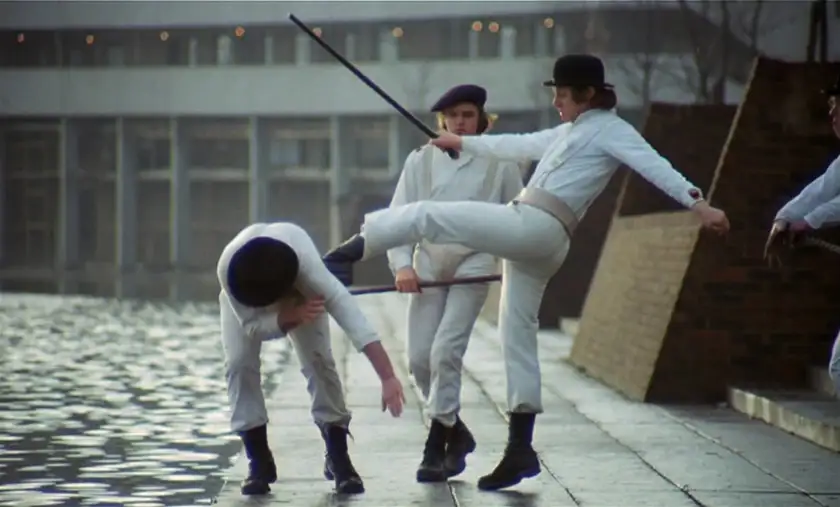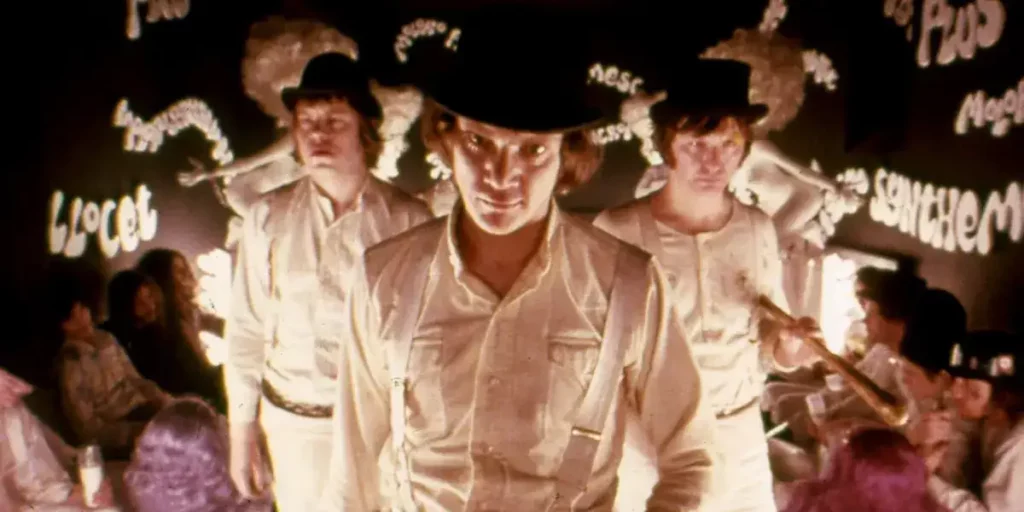In A Clockwork Orange, Stanley Kubrick creates a proper horror show served with commentary on free will and pent-up violence of the 70s youth.
A Clockwork Orange stands as a salacious and uncouth provocation of audiences, forcing viewers to look at society in its ugliest state. It shows brutality and horror in its purest form with the hope of upsetting viewers as the boys unleashing these acts do it for no other reason than pure enjoyment. While films before it, and countless films after it, get called into moral questioning for the repercussions that have arisen due to these films’ blatant inclusion of violence, A Clockwork Orange somehow stands the test of time while the others wither away from the public’s frontal cortex. It stands as a permanent fixture in the cultural conversation revolving around violence and film while simultaneously holding a cult following. Why is that, you may ask? Because of Stanley Kubrick’s vision.
Kubrick’s 1971 classic follows the narrator, Alex (Malcolm McDowell, of Caligula), a brutally violent member of the British youth who serves as the leader of his gang of droogs. Alex goes about life without any semblance of care or concern, able to fight or talk himself out of any situation and always looking for a reason to exert brutal force. He and his gang galivant around London all hours of the night committing horrific atrocities on the innocent. One night, he takes it too far and kills a woman, amidst an attempted robbery, which finally lands him in prison for 14 years.
Two years into his sentence, however, he gets word of an experimental psychological treatment the state wants to implement with the hope of reforming criminals and ridding them of all their violent impulses. Alex dives at the opportunity to test this not-yet-fully-developed “Ludovico” treatment as it promises to have prisoners out of jail and fully cured within a fortnight. The treatment itself conditions Alex to become physically ill at the sight of sex, violence and inadvertently his favorite song- Ludwig van Beethoven’s Symphony No. 9. Released from prison, but stripped of his free will, Alex is let back onto the streets of London wanting to return to a life that no longer exists for him.
What makes this film stand out amongst others who have had flash-in-the-pan attention due to brutality and nudity is the character study it provides on Alex and young gentlemen like him. Alex is paradoxical, he’s horribly violent but has an unwavering appreciation for the arts. He has grotesque impulses but can use charm in circumstances that require it. He will beat up anyone he encounters for no real reason but smacks his friend for interrupting someone singing Beethoven.

A Clockwork Orange works to go beyond its violence to explore the connection between masculinity and brutality. Notably, Alex is a teenager when we meet him. He meets his gang every night at Korova Milk Bar, a bar that serves milk laced with hallucinogenics that come from the breasts of nude female mannequins. The milk bar serves as the lasting connection between adolescence and adulthood. Milk, being a drink linked to childhood, served directly from the breast of a (albeit fake) woman, but laced with a drug that helps get Alex and his droogs ready for a night full of unspeakable violence.
From a psychological standpoint, he is a boy who wants to act on his every whim with the physicality and strength of a man who can cause real damage. Throughout the entirety of the film, Alex is straddling the line between desiring to be an adult, with unbridled free will and resorting back to a whiney child when things don’t go his way.
Kubrick’s film is also brutally honest about the public’s ignorance regarding what to do with delinquents like Alex. Prison keeps them off the streets, but young men being put into prison with even worse men to surround them doesn’t inspire reform in the way the government thinks it does. This Ludovico treatment erases the impulses to act violently but leaves Alex completely defenseless as he begins to encounter those he has wronged in the first act of the film. This conversation of how to handle the uncivil youth serves as this broader conversation within the film.
While Alex is a deeply hate-able character, the conversation posed as to what to do with the likes of him is an endlessly interesting one. Alex is fascinating in the sense that it feels like there are very few characters in film that invoke so much hate and disgust from audiences, yet you want to see what happens to him. You’re never on his side but you are curious to see how his story plays out as you understand the issue of what to do about him has no easy answer.
A Clockwork Orange is a hard film to watch on a difficult topic to discuss. It fails at times to condemn the actions of Alex definitively. It shows violence and brutality, a lot of times against women, with a carelessness that is meant to emphasize its banality in the mind of young uncivil men but maybe doesn’t dig deep enough to the root of why violence breeds such intensive violence.
Within Kubrick’s career, it is clear to see why A Clockwork Orange was an appealing project to reinvent on the big screen in his signature style. It’s controversial and aggressive. It deals with the ugliness of society and the lack of understanding on how to tame problems that fester within it. From a stylistic standpoint, Kubrik’s mise-en-scene is as brash as the subject material. Sharp angles, vibrant lighting and hard cuts compliment the serrated characters and the harshness they inflict upon the world.
There’s a line in the film that talks about “the thrill of violence and the urge to live easy”, which really encapsulates Alex’s only drive. He wants an easy, consequenceless life. Those conducting the Ludovico treatment only desire to get Alex to stop by whatever means necessary, not even entertaining the higher ethics of what the reality of this treatment is for its victims. Kubrick creates a harsh and unforgiving picture of society in this film, a society that thinks in black and white refusing to entertain color. The quick and easy fix is seemingly the only one worth indulging in.
A Clockwork Orange is now available to watch on digital and on demand. Read our reviews of Stanley Kubrick’s Paths of Glory, Barry Lyndon, and The Shining.

